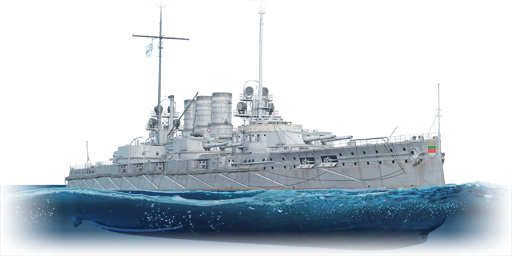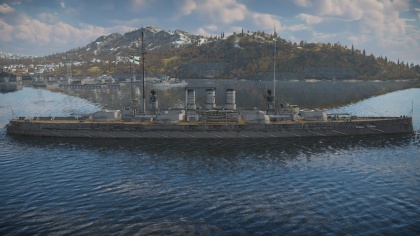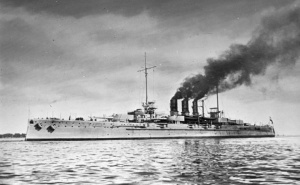Difference between revisions of "SMS Helgoland"
Bonisducks (talk | contribs) (→History) (Tag: Visual edit) |
Bonisducks (talk | contribs) (→External links: Done history and references.) (Tag: Visual edit) |
||
| Line 126: | Line 126: | ||
* ''topic on the official game forum;'' | * ''topic on the official game forum;'' | ||
* ''other literature.'' --> | * ''other literature.'' --> | ||
| − | + | === Citations === | |
| + | <references /> | ||
| − | + | === Bibliography === | |
| − | |||
| + | * World War 1 Co. (1998). Helgoland Class Dreadnought Battleship. Retrieved November 30, 2020, from <nowiki>http://www.worldwar1.co.uk/battleship/sms-helgoland.html</nowiki> | ||
| + | * Military Factory. (2020, September 4). SMS Helgoland Dreadnought Battleship. Retrieved November 30, 2020, from <nowiki>https://www.militaryfactory.com/ships/detail.asp?ship_id=sms-helgoland-battleship-imperial-german-navy</nowiki> | ||
{{Germany battleships}} | {{Germany battleships}} | ||
Revision as of 14:39, 30 November 2020
Contents
Description
The Helgoland-class, SMS Helgoland, 1911 is a rank V German battleship
with a battle rating of 6.3 (AB/RB/SB). It was introduced in Update "New Power".
General info
Survivability and armour
Talk about the vehicle's armour. Note the most well-defended and most vulnerable zones, e.g. the ammo magazine. Evaluate the composition of components and assemblies responsible for movement and manoeuvrability. Evaluate the survivability of the primary and secondary armaments separately. Don't forget to mention the size of the crew, which plays an important role in fleet mechanics. Save tips on preserving survivability for the "Usage in battles" section. If necessary, use a graphical template to show the most well-protected or most vulnerable points in the armour.
Mobility
Write about the ship's mobility. Evaluate its power and manoeuvrability, rudder rerouting speed, stopping speed at full tilt, with its maximum forward and reverse speed.
| Mobility Characteristics | |||
|---|---|---|---|
| Game Mode | Upgrade Status | Maximum Speed (km/h) | |
| Forward | Reverse | ||
| AB | |||
| Upgraded | 44 | 25 | |
| RB/SB | |||
| Upgraded | 38 | 22 | |
Armament
Primary armament
Provide information about the characteristics of the primary armament. Evaluate their efficacy in battle based on their reload speed, ballistics and the capacity of their shells. Add a link to the main article about the weapon: {{main|Weapon name (calibre)}}. Broadly describe the ammunition available for the primary armament, and provide recommendations on how to use it and which ammunition to choose.
Secondary armament
Some ships are fitted with weapons of various calibres. Secondary armaments are defined as weapons chosen with the control Select secondary weapon. Evaluate the secondary armaments and give advice on how to use them. Describe the ammunition available for the secondary armament. Provide recommendations on how to use them and which ammunition to choose. Remember that any anti-air armament, even heavy calibre weapons, belong in the next section. If there is no secondary armament, remove this section.
Torpedo armament
Torpedo launchers are standard equipment on many ships and boats. Torpedoes are a significant means of defeating an opponent. Evaluate the position of the torpedo launchers, discuss the ammunition available, firing specifics such as dead zones, features of the torpedoes themselves, etc. If there is no torpedo armament, remove this section.
Usage in battles
Describe the technique of using this ship, the characteristics of her use in a team and tips on strategy. Abstain from writing an entire guide – don't try to provide a single point of view, but give the reader food for thought. Talk about the most dangerous opponents for this vehicle and provide recommendations on fighting them. If necessary, note the specifics of playing with this vehicle in various modes (AB, RB, SB).
Modules
| Tier | Seakeeping | Unsinkability | Firepower | ||
|---|---|---|---|---|---|
| I | Dry-Docking | Tool Set | 305 mm Psgr. L/3.4 | ||
| II | Rudder Replacement | Fire Protection System | Auxiliary Armament Targeting | 150 mm Sprgr. L/3.2 Bdz | |
| III | Propeller Replacement | Shrapnel Protection | Ventilation | Primary Armament Targeting | Improved Rangefinder |
| IV | Engine Maintenance | New Pumps | Ammo Wetting | ||
Pros and cons
Pros:
- Massive firepower
- Heavily armored, making it hard to sink
- Has access to torpedoes
Cons:
- Has no anti-air defenses
History
SMS Helgoland was the lead ship of the Helgoland-class of pre-WWI dreadnought battleships. Being an incremental improvement upon the preceding Nassau-class battleships, they featured a more powerful 12-inch (305 mm) battery and improved propulsion system. Built in 1909, she saw service in World War 1; she served in the raid on Scarborough, Battle of Riga and Battle of Jutland. After the war, Helgoland was handed to the United Kingdom as a war reparation; she was scrapped in 1924.[1][2]
Design and construction
The Helgoland-class was of overall similar construction to the preceding Nassau-class. They displaced 22 500 tons standard, and with 28 000 shaft horsepower, were capable of making 20 knots (37 km/h).[1] The Helgoland featured a unique hexagonal main armament arrangement, similar to the Nassau-class, but had a higher-calibre main battery of twelve 12-inch (305 mm) guns in six twin-turrets.[1] The Helgoland also carried numerous 5.9-inch (150-mm) guns and 88 mm guns in casemate mountings.[1] She later gained four 88-mm high-angle anti-aircraft weapons, but this is not reflected in the game. As a result, the 1911 Helgoland didn’t have any anti-aircraft protection. Finally, the Helgoland carried six 50-cm torpedo tubes mounted underneath the waterline.[1]
The Helgoland was laid down in November of 1908, named after the Heligoland archipelago in the North Sea.[2] She was launched in September of 1909. She was completed and commissioned on August 23rd 1911, after the completion of three years of construction.[1]
Operational history
The Helgoland entered service with the German 1st Battle Squadron, which formed the core of the German battleship strike force.2 She participated in some training exercises before the war, along with her sister ships. After the start of the First World War, Helgoland saw her first combat action at the Raid on Scarborough, Hartlepool and Whitbey. Due to heavy fog, the British and German forces never directly engaged despite the fact that Helgoland was at one point just 10 nautical miles away from the British fleet. Helgoland later participated in the Battle of the Gulf of Riga, though she failed to see major combat action.
Helgoland participated in the Battle of Jutland, where she was located at the centre of the German battleship line. As a result, she saw less action than ships at the front of the formation, such as the battleship Konig. Despite this, Helgoland still fired 63 12-inch shells, and took a hit from a 15-inch shell that caused a moderate amount of flooding.[1][2] The battle of Jutland was a tactical victory for the German fleet, having lost less ships and men than the British. However, it was a strategic victory for the British as the German grand fleet would set sail in large numbers again.[1][2]
Helgoland, along with her sister ships, were docked at Wilhelmshaven until the end of the war; she was supposed to participate in the suicidal German raid against the British fleet, in an attempt to secure better surrendering conditions.[2] However, this failed as the sailors manning the ship mutinied.[2] Thus, Helgoland was handed to the British as a war reparation, along with her three sister ships. She was eventually scrapped by 1924.[2]
Media
- Videos
See also
Links to articles on the War Thunder Wiki that you think will be useful for the reader, for example:
- reference to the series of the ship;
- links to approximate analogues of other nations and research trees.
External links
Citations
Bibliography
- World War 1 Co. (1998). Helgoland Class Dreadnought Battleship. Retrieved November 30, 2020, from http://www.worldwar1.co.uk/battleship/sms-helgoland.html
- Military Factory. (2020, September 4). SMS Helgoland Dreadnought Battleship. Retrieved November 30, 2020, from https://www.militaryfactory.com/ships/detail.asp?ship_id=sms-helgoland-battleship-imperial-german-navy
| Germany battleships | |
|---|---|
| Nassau-class | SMS Nassau · SMS Westfalen |
| Helgoland-class | SMS Helgoland · SMS Ostfriesland |
| Kaiser-class | SMS Kaiser |
| Bayern-class | SMS Bayern · SMS Baden · SMS Sachsen |






